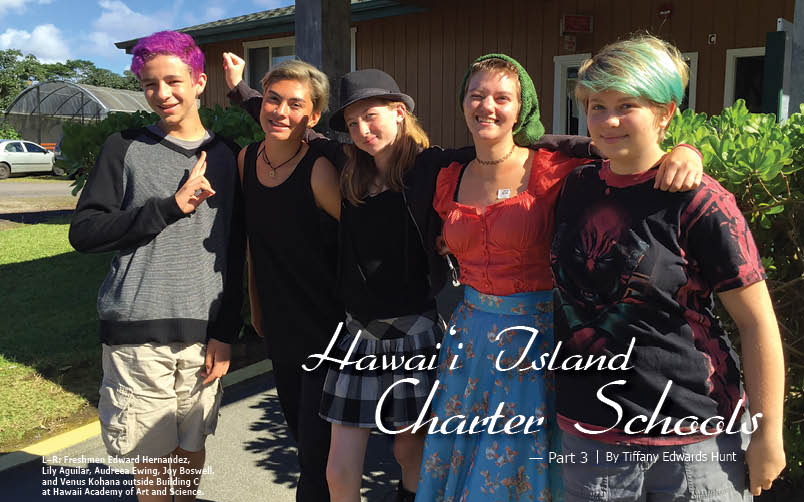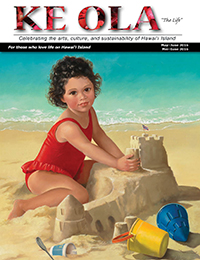
Hawai‘i Island Charter Schools, part 3
By Tiffany Edwards Hunt
In the past two issues of Ke Ola Magazine, we’ve explored various charter schools on the island, describing these public schools that are focused on Hawaiian language and culture or are project-based. They are unique in character, in location, and in struggles to exist with limited budgets and a lack of real political support from the Department of Education (DOE) and State Legislature.
In this issue, Ke Ola Magazine focuses on several more charter schools that are no exception for their uniqueness. These are project-based schools with opportunities for youth to delve into passions they may not find or be able to pursue elsewhere.
How these schools came to be and continue to exist inspire conversations about education and schools in our diverse communities around the island.
Unlike the traditional DOE school, charter schools don’t receive subsidies for the three basics in education: transportation, facilities and food.
Hawai‘i Academy of Art and Science Public Charter School
Steve Hirakami, the principal of Hawai‘i Academy of Art and Science Public Charter School (HAAS), says it first began with a couple of teachers at Pahoa High and Intermediate School. Wendy Schaeffer and Gail Loeffler had this idea for another educational option in Pāhoa.
“We were all so amazed at the disrespect, violence, and profanity,” Steve recalls. “Nobody wanted to do anything about it. It was not conducive to a learning environment. Kids were basically disrespecting themselves.”
With the passage of the 1999 Charter School Act, Wendy and Gail wrote a detailed implementation plan. In the fall of 2000-2001, these two women took their bold step with HAAS.

Steve and other HAAS representatives gave their presentation to the Board of Education, got acceptance of their implementation plan, and received their charter document. “That day, there was no building, desks, teachers, a special-education plan, food service, transportation—literally all we had was a piece of paper.”
From June 21–Sept. 4, 2001, the HAAS group worked to arrange food to come from Keonepoko Elementary School, transportation to come from Robert’s Hawaii, and a lease for the space with New Hope Christian Fellowship Puna church located in Pāhoa.
Steve addressed the crowd of students gathered for the first day of school, noting the rules, especially the “golden rule,” “treat everyone with aloha and everything will work out.” Sixteen years later, HAAS has its brand, “aloha in education.”
“The environment for learning is paramount,” Steve says. “Respect each other.”
HAAS has instilled community service in the school, making 144 hours of charity work a graduation requirement.
HAAS uses Total Quality Management in Education, Margaret Byrnes’ pedagogy, which involves stakeholders and is what Steve describes as “a bottom-up way of running things.”
“It’s really interesting to manage a school from the bottom, up. Teachers have a say in the hiring of fellow teachers,” he says. “The kids define the school,” Steve says. “They like the school. They are the face of this school. I think the defining factor is that the kids want to be here.”
HAAS was able to have its campus on Post Office Road in Pāhoa appraised at $1.1 million and borrowed money to build its administration building, longhouse, and pavilion for its high school campus.
In 2007, HAAS had the opportunity to buy the neighboring seven acres to form its upper middle school campus among the fallow macadamia nut orchards. With an updated appraisal of $2.2 million, they were able to borrow money for the land purchase. There is now the potential to acquire another 14 acres to make a total footprint of 25 acres. “We can consolidate the school and save on incredible rent we pay on the outside,” Steve says.
Volcano School of Arts and Sciences
A group of parents and teachers in Volcano spearheaded the opening of Volcano School of Arts and Sciences (VSAS) in 2001. Today, the school resides on two different parcels: land owned by Kamehameha Schools adjacent to Hawai‘i Volcanoes National Park and a parcel on Department of Education land originally donated in 1914 by the Lee family for a school for Volcano’s children. Students on both campuses have the luxury of being in the forest amongst native and endemic plants.
The school has “very active, hands-on learning,” which is place-based, focused on scientific and cultural learning.
There are 156 students in the school in all, and eighth grade is the highest grade.
Kathleen Kam, who can be credited for the mural outside the KTA Super Stores in downtown Hilo, is one of a number of artists who participates in the Artists in the Schools program that VSAS offers through grants. She comes to the school once a week to teach the students. Right now they are working with Window Books. Since the fifth grade class is reading Island of the Blue Dolphins, their window books take that focus.
Another highlight of the school—learning trips. For instance, the third grade class goes on a learning trip every Monday to the Hawai‘i Volcanoes National Park, Ka‘ū, and around the island looking at geology and biology. Many of the learning trips are led by Jeff Judd, a former law enforcement ranger for the national park. Learning trips are fully integrated into the school curriculum, which is based on the Common Core Standards and the mission and vision of the school.
VSAS’ counselor Kim Miller teaches a social and emotional curriculum that includes, feelings, awareness, mindfulness, self-control, and resolving problems peacefully. It promotes a “peaceful classroom.” Kim says that she teaches students to have physiological awareness, noting, for example, how deep breaths can calm you down.
The fact is, though, “Every kid who comes here, the state gives about a thousand dollars less per student than the traditional DOE school,” the VSAS Assistant Director Chris King-Gates noted. One of the most expensive aspects of the school is transportation. Some students ride on Hele-On buses from as far away as Ocean View and South Point Road to get to VSAS. The school has a bus that only goes as far as Nā‘ālehu.
The educational director, Kalima Cayir says, “The bus costs the school $66,000 per year, about $20,000 of which is covered through usage fees. The school is currently seeking grants and funding to establish a financial aid program for families who cannot afford to pay the $75 per month bus fee.”
One of the school’s greatest success stories is its school lunch program led by Amalie Dorn. She started it in 2013, as a parent interested in her own children’s nutrition. Meals are prepared at the Keakealani House, the former Keakealani Education Outdoor Center where the middle school classes are taught.
“We want to prepare meals that are fresh, with as much local produce as possible,” Amalie says. “We don’t cook with salt, sugar, or seasonings.”
The Hawaii Child Nutrition Program is looking at her program to model, as VSAS was the first school to institute a farm-to-school program.
Currently, Amalie is working on a School Food Hui program with Kona Pacific Public Charter School. Fourteen charter schools have signed on to be partners in the School Food Hui, which will involve sharing a business office, menu planning, and buying. All the schools will pay into the program. A Kona Pacific staffer wrote the grant for the first three years of funding. “The DOE is looking at our model for their own,” noted Amalie. “It’s exciting.”
Amalie also chairs the Friends of VSAS board, which recently received a $618,000 grant to plan and design a new campus on the same land as the Keakealani Building. More recently they received a $285,000 GIA grant (Hawai‘i State Grant In Aid) to build a community commercial kitchen. The vision for the new campus is to provide community access to our commercial kitchen, multi-purpose center and library, according to Kalima.
Connections Public Charter School
Down the hill, at Mountain View Elementary School, Connections Public Charter School started as a school within a school in 2000.
Connections’ nonprofit, Community-Based Education Support Services, looked to downtown Hilo for a lease of the Kress Building, and ultimately bought the building from the Fong family.
Over the years, the school’s nonprofit organization has had three other building tenants: Boyd Hawaii LLC, which is the school’s food service provider, Wallace Theaters, and Akmal Foods Suraya’s Indian Kitchen in the 45,984 square foot building.
Located in a tsunami inundation zone, however, the school acquired a 65-year lease on 73 acres in Kaumana in hopes of relocating from Hilo bayfront. The school applied for a special-use permit to develop a portion of the property into a school and also a “multi-generational community center,” according to Heather McDaniel, who has been with the school for 16 years. The county planning commission and the Circuit Court, on appeal, both denied the special-use permit. Another appeal is pending, but, for now, the school’s expansion plan was thwarted by what Heather described as “NIMBYS that don’t want a school there, or any development.” NIMBY, as you are likely aware, is an acronym for “not in my backyard.”
“Part of the charter school challenge is that there is no facilities funding,” Heather says. She credits “creative people on the board” who snatched up the three-story Kress building.
On the first floor, where there used to be a five-and-dime store and a soda fountain, is the elementary school, along with the office, storage, and cafeteria. Akmal Foods Suraya’s Indian Kitchen takes up a corner of the front window area.
Administrators’ offices, middle school and high school are housed on the second floor that was recently renovated with $1.5 million in grant-in-aid funds from the State Legislature. All-in-all, the school takes up 25,457 square feet of the building.
The school has a computerized design class referred to as the “makery” taught by Bill Thorpe and Greg Henkel. Using computers and a 3D laser printer, the students make things out of wood, plastic and metal.
“We are kind of having to untrain them because they are experienced with gaming and take off,” Greg pointed out. “We have to note the technology is sophisticated and they cannot just push buttons.”
Connections students also are involved in video and music production and dance. The school has finished creating its music studio on the second floor.
Laupahoehoe Community Public Charter School
While the other public charter schools might be having facility issues, Laupāhoehoe Community Public Charter School doesn’t have any issues with space.
Michael Okoye is the third director of the school since it converted to a charter school in 2012–2013.
One teacher from DOE stayed; Todd Otake teaches music, agriculture, and communications.
Office manager, Tracy Jardine also stayed. Tracy has lived in Waipunalei for the last 37 years—her children attended the school, as did her husband. “This community needs this school. It’s the last thing we’ve got.”
The school has students from pre-kindergarten to grade 12.
Currently the school population is 242, and if you count the students enrolled in the school’s online “Harmony” program it’s 301.
Like other charter schools, there are fewer students in the higher grades. Michael has noticed a trend of one small class and one big class, say a small freshman class, followed by a large sophomore class, and is not sure why that is the case.
Laupāhoehoe offers a woodworking class by woodworker Peter Ziroli.
They received a Social and Emotional Learning (SEL) grant which comes with a curriculum and helps kids learn how to handle emotions and conflict. Laupāhoehoe has also partnered with Kuikahi Mediation to do peer mediation.
In another building, there are two classrooms for individuals with special abilities and needs, including one room devoted entirely to sensory objects for students with autism or on the
autism spectrum.
DOE has tapped Laupāhoehoe school for a facelift, since it is a conversion school and the facility is still owned by DOE. Each of the classrooms are expected to be painted in the coming months.
One change Laupāhoehoe has seen this year is the students all have Chrome Books and are working on a program called “Grad Point,” which is an online curriculum aligned with Common Core standards and allows the school to hone in on the students’ strengths and weaknesses.
“What we’re trying to do is meet the needs of the community, at the same time we’re transitioning toward attracting more students,” Michael says. “The attraction involves offering things like woodshop and also autoshop, some of the more technical aspects of education that will be useful out of school.”
Michael is eager to see the school “move further along the road to academic progress.”
“I don’t want to say our focus is test results, but we need to improve,” he says. Students need to become better readers as well, Michael noted. He also would like to see a more robust computer science program, and a robust agriculture program along with a strong vocational arts program.
“We want to prepare kids to live here, but also participate in the global community.”
Indeed, despite their unique challenges, the charter schools toured for this series all seem to share the common goal of passing along practical knowledge and at the same time they are trying to prepare students for the world outside their small and diverse communities. ❖
Contact Hawai‘i Academy of Art and Science Public Charter School: 808.965.3730
Contact Volcano School of Arts and Sciences: 808.985.9800
Contact Connections Public Charter School: 808.961.3664
Contact Laupāhoehoe Community Public Charter School: 808.962.2200
Contact writer and photographer Tiffany Edwards Hunt



